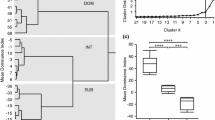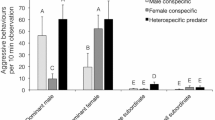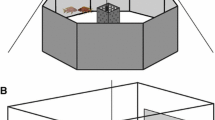Abstract
Research on cichlid fish has revealed remarkable cross-species variation in social and reproductive behavior. Recently, several species of African cichlids have been shown to produce acoustic signals, typically in conjunction with the visual behavioral displays associated with mate choice and competition. However, the recent research conducted on cichlid sound production has focused largely on polygynous cichlids with female care and on species from Lake Malawi and Lake Victoria. In this study, we examined whether sound production occurs in a group-living, cooperative, biparental cichlid species, Neolamprologus pulcher, endemic to Lake Tanganyika, the oldest of the African Great Lakes. Neolamprologus pulcher is a highly social cichlid that lives in complex groups that are socially stratified. We investigated whether N. pulcher performed acoustic signals to each other either during competitive resource contests between size-matched males, or during courtship between male and female breeding pairs. Although the fish displayed prototypical visual displays of aggression, submission, and courtship in the appropriate context, we found no evidence of vocal sound production. Our findings suggest that cichlid sound production was not essential for the evolution of complex social behavior.



Similar content being viewed by others
References
Akamatsu, T., T. Okumura, N. Novarini & H. Y. Yan, 2002. Empirical refinements applicable to the recording of fish sounds in small tanks. Journal of the Acoustical Society of America 112: 3073–3082.
Amorim, M. C. P., 2006. Diversity of sound production in fish. In Ladich, F., S. P. Collin, P. Moller & B. G. Kapoor (eds), Communication in Fishes. Science Publishers, Enfield, NH: 71–104.
Amorim, M. C. P. & V. C. Almada, 2005. The outcome of male–male encounters affects subsequent sound production during courtship in the cichlid fish Oreochromis mossambicus. Animal Behaviour 69: 595–601.
Amorim, M. C. P., M. E. Knight, Y. Stratoudakis & G. F. Turner, 2004. Differences in sounds made by courting males of three closely related Lake Malawi cichlid species. Journal of Fish Biology 65: 1358–1371.
Amorim, M. C. P., J. M. Simões, P. J. Fonseca & G. F. Turner, 2008. Species differences in courtship acoustic signals among five Lake Malawi cichlid species (Pseudotropheus spp.). Journal of Fish Biology 72: 1355–1368.
Balshine-Earn, S. & A. Lotem, 1998. Individual recognition in a cooperatively breeding cichlid: evidence from video playback experiments. Behaviour 135: 369–386.
Bertucci, F., M. Beauchaud, J. Attia & N. Mathevon, 2010. Sounds modulate males’ aggressiveness in a cichlid fish. Ethology 116: 1179–1188.
Bertucci, F., J. Attia, M. Beauchaud & N. Mathevon, 2012. Sounds produced by the cichlid fish Metriaclima zebra allow reliable estimation of size and provide information on individual identity. Journal of Fish Biology 80: 752–766.
Boersma, P. & D. Weenink, 2013. Praat: doing phonetics by computer (version 5.2.15). http://www.fon.hum.uva.nl/praat/.
Bolker, B. M., 2008. Ecological Models and Data in R. Princeton University Press, Princeton, NJ.
Bradbury, J. W. & S. L. Vehrencamp, 1998. Principles of Animal Communication, 2nd ed. Sinauer Associates, Sunderland, MA.
Buchner, A. S., K. A. Sloman & S. Balshine, 2004. The physiological effects of social status in the cooperatively breeding cichlid Neolamprologus pulcher. Journal of Fish Biology 65: 1080–1095.
Carleton, K. L., T. C. Spady & T. D. Kocher, 2006. Visual Communication in East African Cichlid Fishes: Diversity in a Phylogenetic Context. Communication in Fishes. Science Publishers, Enfield, NH: 487–515.
Coeckelberghs, V., 1975. Territorial, spawning and parental behaviour of Lamprologus brichardi Poll 1974 (Pisces, Cichlidae). Annales de la Société Royale Zoologique de Belgique 105: 73–86.
Day, J. J., S. Santini & J. Garcia-Moreno, 2007. Phylogenetic relationships of the Lake Tanganyika cichlid tribe Lamprologini: the story from mitochondrial DNA. Molecular Phylogenetics and Evolution 45: 629–642.
Desjardins, J. K., K. A. Stiver, J. L. Fitzpatrick, N. Milligan, G. J. Van Der Kraak & S. Balshine, 2008. Sex and status in a cooperative breeding fish: behavior and androgens. Behavioral Ecology and Sociobiology 62: 785–794.
Freeberg, T. M., R. I. Dunbar & T. J. Ord, 2012. Social complexity as a proximate and ultimate factor in communicative complexity. Philosophical Transactions of the Royal Society B: Biological Sciences 367(1597): 1785–1801.
Goodwin, N. B., S. Balshine-Earn & J. D. Reynolds, 1998. Evolutionary transitions in parental care in cichlid fish. Proceedings of the Royal Society of London Series B: Biological Sciences 265: 2265–2272.
Grafe, T. U. & T. C. Wanger, 2007. Multimodal signaling in male and female foot-flagging frogs Staurois guttatus (Ranidae): an alerting function of calling. Ethology 113: 772–781.
Heg, D. & Z. Bachar, 2006. Cooperative breeding in the Lake Tanganyika cichlid Julidochromis ornatus. Environmental Biology of Fishes 76: 265–281.
Hick, K., A. R. Reddon, C. M. O’Connor & S. Balshine, 2014. Strategic and tactical fighting decisions in cichlid fishes with divergent social systems. Behaviour 151: 47–71.
Johnstone, R. A., 1996. Multiple displays in animal communication: backup signals and multiple messages. Philosophical Transactions of the Royal Society of London Series B: Biological Sciences 351: 329–338.
Jordan, L. A., M. Y. Wong & S. Balshine, 2010. The effects of familiarity and social hierarchy on group membership decisions in a social fish. Biology Letters 6: 301–303.
Klett, V. & A. Meyer, 2002. What, if anything, is a Tilapia? – Mitochondrial ND2 phylogeny of tilapiines and the evolution of parental care systems in the African cichlid fishes. Molecular Biology and Evolution 19: 865–883.
Koblmüller, S., K. M. Sefc & C. Sturmbauer, 2008. The Lake Tanganyika cichlid species assemblage: recent advances in molecular phylogenetics. Hydrobiologia 615: 5–20.
Kornfield, I. & P. F. Smith, 2000. African cichlid fishes: model systems for evolutionary biology. Annual Review of Ecology and Systematics 31: 163–196.
Ladich, F., 1997. Agonistic behaviour and significance of sounds in vocalizing fish. Marine and Freshwater Behaviour and Physiology 29: 87–108.
Ladich, F., 2004. Sound production and acoustic communication. In von der Emde, G., J. Mogdans & B. G. Kapoor (eds), The Senses of Fish: Adaptations for the Reception of Natural Stimuli. Springer, Houten: 210–230.
Le Vin, A., B. Mable & K. Arnold, 2010. Kin recognition via phenotype matching in a cooperatively breeding cichlid, Neolamprologus pulcher. Animal Behaviour 79: 1109–1114.
Lobel, P. S., 1998. Possible species specific courtship sounds by two sympatric cichlid fishes in Lake Malawi, Africa. Environmental Biology of Fishes 52: 443–452.
Lobel, P. S., 2001. Acoustic behavior of cichlid fishes. Journal of Aquariculture and Aquatic Sciences 9: 167–186.
Longrie, N., S. Van Wassenbergh, P. Vandewalle, Q. Mauguit & E. Parmentier, 2009. Potential mechanism of sound production in Oreochromis niloticus (Cichlidae). Journal of Experimental Biology 212: 3395–3402.
Maruska, K. P., U. S. Ung & R. D. Fernald, 2012. The African cichlid fish Astatotilapia burtoni uses acoustic communication for reproduction: sound production, hearing, and behavioral significance. PLoS One 7: e37612.
McClintock, W. J. & G. W. Uetz, 1996. Female choice and pre-existing bias: visual cues during courtship in two Schizocosa wolf spiders (Araneae: Lycosidae). Animal Behaviour 52: 167–181.
Myrberg, A. A., E. Kramer & P. Heinecke, 1965. Sound production by cichlid fishes. Science 149: 555–558.
Nelissen, M. H., 1975. Sound production by Simochromis diagramma (Günther) (Pisces, Cichlidae). Acta zoologica et pathologica Antverpiensia 61: 19–24.
Nelissen, M. H., 1978. Sound production by some Tanganyikan cichlid fishes and a hypothesis for the evolution of their communication mechanisms. Behaviour 64: 137–147.
Nelissen, M. H., 1991. Communication. In Keenleyside, M. H. A. (ed.), Cichlid Fishes: Behaviour, Ecology and Evolution, Vol. 2. Chapman and Hall, New York: 225–257.
Owren, M. J., 2008. GSU Praat Tools: scripts for modifying and analyzing sounds using Praat acoustics software. Behavior Research Methods 40: 822–829.
R Development Core Team, 2013. R: A Language and Environment for Statistical Computing. R Foundation for Statistical Computing, Vienna. http://www.R-project.org.
Reddon, A. R., M. R. Voisin, N. Menon, S. E. Marsh-Rollo, M. Y. Wong & S. Balshine, 2011. Rules of engagement for resource contests in a social fish. Animal Behavior 82: 93–99.
Rice, A. N. & P. S. Lobel, 2003. The pharyngeal jaw apparatus of the Cichlidae and Pomacentridae: function in feeding and sound production. Reviews in Fish Biology and Fisheries 13: 433–444.
Ripley, B., B. Venables, D. M. Bates, K. Hornik, A. Gebhardt & D. Firth, 2014. Support Functions and Datasets for Venables and Ripley’s MASS. R Package Version 7.3-30. http://www.CRAN.R-project.org/package=MASS.
Rowe, C., 1999. Receiver psychology and the evolution of multicomponent signals. Animal Behaviour 58: 921–931.
Schwarzer, J., B. Misof, D. Tautz & U. K. Schliewen, 2009. The root of the East African cichlid radiations. BMC Evolutionary Biology 9: 186.
Schwarz, A. L., 1974. The inhibition of aggressive behavior by sound in the cichlid fish, Cichlasoma centrarchus. Zeitschrift fuer Tierpsychologie 35: 508–517.
Schwarz, A. L., 1980. Sound production and associated behavior in a cichlid fish, Cichlasoma centrarchus. II. Breeding pairs. Environmental Biology of Fishes 5: 335–342.
Seehausen, O., 2006. African cichlid fish: a model system in adaptive radiation research. Proceedings of the Royal Society B: Biological Sciences 273: 1987–1998.
Simões, J. M., I. G. Duarte, P. J. Fonseca, G. F. Turner & M. C. Amorim, 2008. Courtship and agonistic sounds by the cichlid fish Pseudotropheus zebra. Journal of the Acoustical Society of America 124: 1332–1338.
Smith, C. L. & C. S. Evans, 2008. Multimodal signaling in fowl, Gallus gallus. Journal of Experimental Biology 211: 2052–2057.
Smith, A. R. & M. J. van Staaden, 2009. The association of visual and acoustic courtship behaviors in African cichlid fishes. Marine and Freshwater Behaviour and Physiology 42: 211–216.
Sopinka, N., J. Fitzpatrick, J. Desjardins, K. Stiver, S. Marsh-Rollo & S. Balshine, 2009. Liver size reveals social status in the African cichlid Neolamprologus pulcher. Journal of Fish Biology 75: 1–16.
Stiver, K. A., J. Fitzpatrick, J. K. Desjardins & S. Balshine, 2006. Sex differences in rates of territory joining and inheritance in a cooperatively breeding cichlid fish. Animal Behaviour 71: 449–456.
Sturmbauer, C., W. Salzburger, N. Duftner, R. Schelly & S. Koblmüller, 2010. Evolutionary history of the Lake Tanganyika cichlid tribe Lamprologini (Teleostei: Perciformes) derived from mitochondrial and nuclear DNA data. Molecular Phylogenetics and Evolution 57: 266–284.
Sturmbauer, C., M. Husemann & P. D. Danley, 2011. Explosive speciation and adaptive radiation of East African cichlid fishes. In Zachos, F. E. & J. C. Habel (eds), Biodiversity Hotspots: Distribution and Protection of Conservation Priority Areas. Springer, Heidelberg: 333–362.
Taborsky, M. & D. Limberger, 1981. Helpers in fish. Behavioral Ecology and Sociobiology 8: 143–145.
Taborsky, M. & A. Granter, 1998. Behavioural time–energy budgets of cooperatively breeding Neolamprologus pulcher (Pisces: Cichlidae). Animal Behaviour 56: 1375–1382.
Taves, M. D., J. K. Desjardins, S. Mishra & S. Balshine, 2009. Androgens and dominance: sex-specific patterns in a highly social fish Neolamprologus pulcher. General and Comparative Endocrinology 161: 202–207.
Verzijden, M. N., J. van Heusden, N. Bouton, F. Witte, C. ten Cate & H. Slabbekoorn, 2010. Sounds of male Lake Victoria cichlids vary within and between species and affect female mate preferences. Behavioral Ecology 21: 548–555.
Wong, M. Y. L. & S. Balshine, 2011. The evolution of cooperative breeding in the African cichlid fish, Neolamprologus pulcher. Biological Reviews 86: 511–530.
Wong, M. Y. L., L. A. Jordan, S. Marsh-Rollo, S. St-Cyr, J. O. Reynolds, K. A. Stiver, J. K. Desjardins, J. L. Fitzpatrick & S. Balshine, 2012. Mating systems in cooperative breeders: the roles of resource dispersion and conflict mitigation. Behavioral Ecology 23: 521–530.
Acknowledgments
We thank Fizza Jafri for assistance with data collection, Constance O’Connor for assistance with statistical analysis, and Adam Reddon for helpful comments on the manuscript. This research was funded by a Discovery and Equipment grant from the Natural Sciences and Engineering Research Council of Canada and an Ontario Innovation Trust and Canadian Foundation for Innovation award provided to SB. KP is supported by the Social Sciences and Humanities Research Council of Canada. SB is supported by the Canada Research Chair Program.
Author information
Authors and Affiliations
Corresponding author
Additional information
Guest editors: S. Koblmüller, R. C. Albertson, M. J. Genner, K. M. Sefc & T. Takahashi / Advances in Cichlid Research: Behavior, Ecology and Evolutionary Biology
Rights and permissions
About this article
Cite this article
Pisanski, K., Marsh-Rollo, S.E. & Balshine, S. Courting and fighting quietly: a lack of acoustic signals in a cooperative Tanganyikan cichlid fish. Hydrobiologia 748, 87–97 (2015). https://doi.org/10.1007/s10750-014-1933-2
Received:
Accepted:
Published:
Issue Date:
DOI: https://doi.org/10.1007/s10750-014-1933-2




